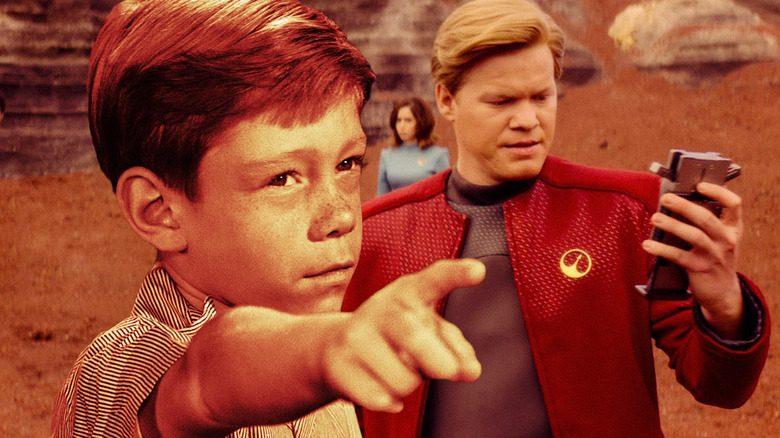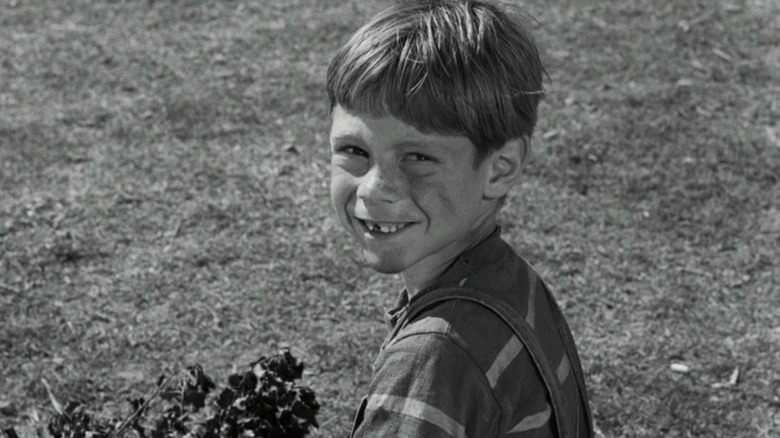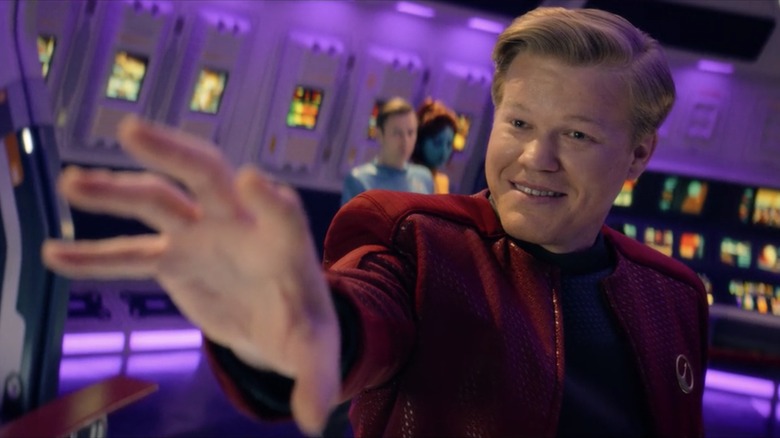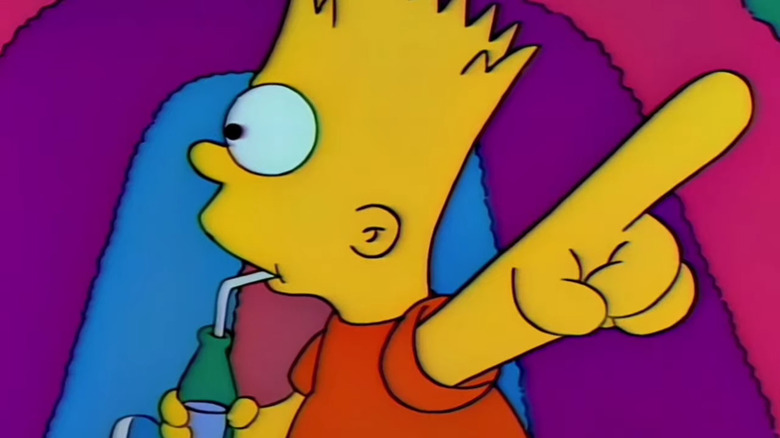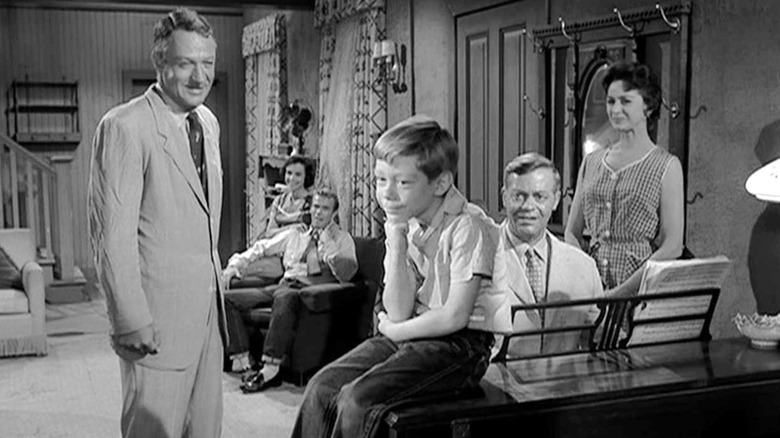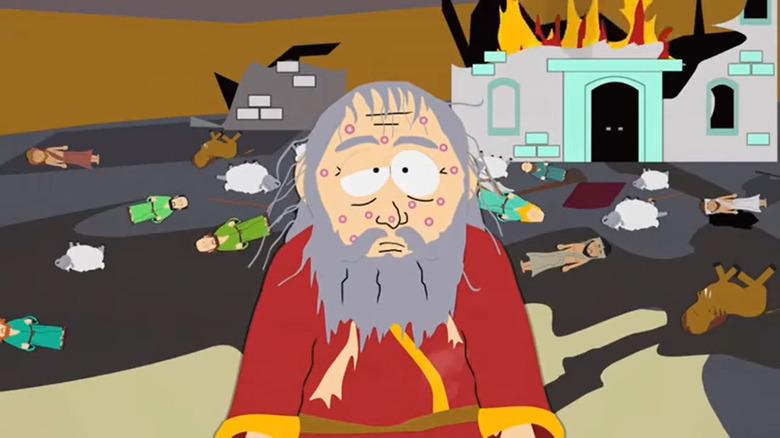How Black Mirror Outdid A Classic Twilight Zone Episode
Say what you will of the Netflix era of "Black Mirror," but there's at least one episode everyone agrees is pretty great. "USS Callister," the season 4 premiere centered around a guy who reveals his ugly side in his own personal VR video game, is a clear fan favorite. What made it so good? Well, there's the way it gives us the usual final act twist surprisingly early on, revealing that it's Nanette (Cristin Milioti) who's our actual, far-more-likeable protagonist. Then there's the way the episode's main setting, a "Star Trek"-inspired virtual reality world that the characters are left to explore, leads to so many more storytelling opportunities ahead of them. (That's why the news that the episode's getting a sequel shouldn't be too surprising.)
But the main appeal of "USS Callister" is just how emotionally resonant its main plot point is. Seemingly nice guy Robert Daly is gradually revealed to be a bit of a sadist, someone who forces his cloned coworkers to submit to his every whim. Sure, he can comfort himself with the knowledge that these people he's torturing technically aren't real — they're just lifelike digital copies that exist only within his computer — but their pain sure feels real to the audience. It's a plot development that serves up some great social commentary about the general tendency towards misogyny and sadism in certain online gamer circles.
But for "Twilight Zone" fans in the audience, this premise wasn't a new one. The central idea was used in the 1961 episode "It's a Good Life," except instead of a group of people bending over backwards to appease an ego-tripping man-child, they were bending over backwards to appease a literal child. And instead of the kid getting his powers through computers, he got it through magic.
It's a good life for one of them, at least
The season 3 "Twilight Zone" episode took place in a small town that's been isolated — or rather, "wished away" — from the rest of the world. Everyone in the town must think happy thoughts and keep up a pleasant demeanor, because if they do anything to displease six-year-old Anthony (Billy Mumy), they can be "wished away into the cornfield," or lit on fire, or turned into a jack-in-the-box. What makes the episode shine is the subtext that Anthony wasn't born particularly evil; this is just what happens when no one can ever say no to a kid, when the parents know that any form of discipline could mean the end of their own lives. Anthony is reminiscent of later iconic villains like Homelander from "The Boys" or Joffrey from "Game of Thrones," in that it's almost hard to blame him for the monster he's turned into. Almost.
What makes "It's a Good Life" particularly haunting is that there is no happy ending. Anthony ends the episode having just wished into existence a snowstorm that'll kill the town's crops and lead everyone into starvation, and all his parents can do is smile and stay positive. It's a total downer, and this added context helps make the stakes in "USS Callister" feel extra high. Going into season 4, "Black Mirror" had so far given us 13 episodes, 11 of which ended on a note ranging from "somewhat depressing" to "I need a shower." Considering the show's reputation as an even darker "Twilight Zone," it was very easy to imagine an ending to "USS Callister" where Daly won, where the rest of the crew was trapped by him forever. The fact that things actually went right for once made for a delightful, cathartic surprise.
From fantasy to sci-fi
In a 2017 interview with Entertainment Weekly, "Black Mirror" creator and showrunner Charlie Brooker was asked if "It's a Good Life" had been one of the inspirations for "USS Callister." He replied, "You may well be right!"
"We were on the set of an episode from last season, 'Playtest,' and we were talking about virtual reality and video games, and the conversation went to, 'Well, you could be the king of the castle in there, you could have an evil emperor or tyrant.' Which reminded me of that episode, a story they revisited again in ['Twilight Zone: The Movie']. I watched the episode again not that long ago and it's still utterly terrifying ... That was the starting point. What if we do a story about an all-powerful tyrant who cast himself as the hero?"
Of course, it wasn't enough for the show to just take the same fantasy premise and throw it into a sci-fi premise. "Black Mirror" also changed the themes of the story so it was no longer a commentary on bad parenting, or on how absolute power corrupts absolutely. Instead, the episode is a commentary on a specific type of male entitlement that's grown particularly prevalent in online spaces. Daly is not just happy to wallow in his bitterness; he chooses to indulge in his misplaced rage at his coworkers rather than just confront them about his problems head on. He also punishes Nanette simply for not being romantically into him.
Nanette's imprisonment is the big turning point for the episode, where Daly's addiction to torturing his digital coworkers goes from bad (but somewhat understandable) to irredeemable. Real-life Nanette didn't even do anything to Daly, but because she's an attractive woman, she ends up the object of his obsession anyway. Just three years after Gamergate, where female critics and journalists found themselves targets of harassment by predominantly male gamers who felt like they themselves were under attack, Daly's character felt particularly timely.
Sorry Black Mirror, the Simpsons did it first
But before "USS Callister" was able to riff on the premise of "It's a Good Life," "The Simpsons" had already gone and given the story their own modern spin. In the 1991 Halloween episode "Treehouse of Horror II," one of the segments followed Bart as the town monster, and Homer as the unfortunate fool who summoned his wrath. Like Dan Hollis thirty years before him, Homer is transformed into a jack-in-the box for trying to put an end to Bart's reign of terror.
"The Simpsons" keeps up the "Twilight Zone" episode's theme of bad parenting, this time by having the jack-in-the-box Homer still stick around in the narrative. The town's therapist, who is inexplicably not afraid of telling Bart how he feels, diagnoses him as someone who desperately needs attention, and then criticizes Homer for not giving that proper attention to him in the first place. So begins a loving sequence of Bart and a deformed Homer spending some quality father-son time, ending with Bart giving him his body back and the two sharing a tender hug.
Sounds like a happy ending, right? Well, not from Bart's perspective. The idea of giving his father an actual earnest show of affection is so horrible to Bart that he wakes up screaming. It may not be as bleak as the original "Twilight Zone" episode, but for Bart, at least, the story still ends on a horrifying note.
Where The Twilight Zone got the idea from
While "It's a Good Life" might be widely seen as the TV episode that started it all, it too was remixing a previously-told premise. The 1953 short story "It's a Good Life," by writer Jerome Bixby, also followed the all-powerful six-year-old Anthony. The story went to even more disturbing places, like early on when Anthony forces a rat to eat itself for fun. It also has more time to give Anthony some extra nuance. There's a surprisingly sweet passage in the middle that shows that Anthony does have a clear capacity for kindness:
"Somehow, he liked the thoughts of the little creatures in this place better than the thoughts outside; and while the thoughts he picked up here weren't very strong or very clear, he could get enough out of them to know what the little creatures liked and wanted, and he spent a lot of time making the grove more like what they wanted it to be."
He almost immediately goes back to torturing the animals, which sure puts a damper on any wholesomeness you might find in this passage. Still, it's a good example of how much deeper the story is able to take us into Anthony's psyche, without needing to rely on the somewhat clunky dialogue the "Twilight Zone" episode gave us.
The short story follows all the same basic plot beats as the episode would eight years later, with one big difference being the way it withholds the reveal about Peaksville's whereabouts. The fact that Anthony isolated the whole town from the rest of the world is only stated explicitly in the final few moments, as a haunting final reinforcement of just how far his powers reach and just how hopeless everyone else's circumstances are.
A tale as old as time
There's no clear predecessor to Bixby's short story, but most mythologies offer a few tales that scratch the same itch. "The Book of Job" in the Bible, for instance, is all about how a guy has everything in his life taken away from him just so God could make a point to Satan. His life is ruined at the whims of an all-powerful being, and it's restored at the end because he continues to honor God even as He basically tortures him for no apparent reason. When Job insists that he loves God anyway, is it really all that different from the townsfolk in "It's a Good Life" continuing to praise Anthony even as he brings them nothing but fear and misery?
Bixby takes any sense of righteousness out of that story, reframing Job's actions as less of a virtue and more as a sign of his spineless self-preservation. It's a story that confronts us with the possibility that the powers that be — whether it's God, the government, the general chaos of the universe — are genuinely selfish and wrathful, that they don't deserve our love or gratitude but only our fear and contempt. "It's a Good Life" traps its reader in that feeling, and maybe that's why the story's endured as long as it has.
The concept of "It's A Good Life" was revisited in the 1983 "Twilight Zone" movie, and was (sort of) revisited in the 2019 reboot. Odds are, we'll be seeing the story on-screen again sometime soon. As long as bad people still hold disproportionate power in our society and as long as bad things keep happening to good people, the premise behind "It's a Good Life" will always resonate.
